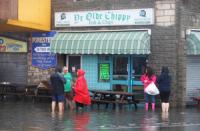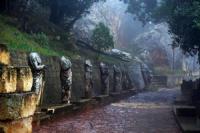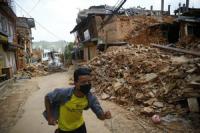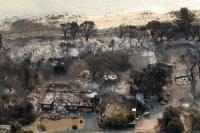-
The old, dirty, creaky U.S. electric grid would cost $5 trillion to replace. Where should infrastructure spending go?

The electric grid is an amazing integrated system of machines spanning an entire continent. The National Academy of Engineering has called it one of the greatest engineering achievements of the twentieth century. But it is also expensive. By my analysis, the current (depreciated) value of the U.S. electric grid, comprising power plants, wires, transformers and poles, is roughly $1.5 to $2 trillion. To replace it would cost almost $5 trillion. That means the U.S. electric infrastructure, which already contains trillions of dollars of sunk capital, will soon need significant ongoing investment just to keep things the way they are. There is no path toward shoring up or upgrading the U.S. electric grid that does not require investment – even just maintaining what we have will cost hundreds of billions, if not trillions, of dollars over the next decade. The bigger question is: As we continue to replace and rebuild this amazing grid, what technologies should we focus on?
-
-
Extreme sea levels could endanger European coastal communities

Massive coastal flooding in northern Europe that now occurs once every century could happen every year if greenhouse gas emissions continue to rise, according to a new study. New projections considering changes in sea level rise, tides, waves and storm surge over the twenty-first century find global warming could cause extreme sea levels to increase significantly along Europe’s coasts by 2100. Extreme sea levels are the maximum levels of the sea that occur during a major storm and produce massive flooding.
-
-
Offshore fault system could produce onshore magnitude 7.3 quake in southern California
A fault system that runs from San Diego to Los Angeles is capable of producing up to magnitude 7.3 earthquakes if the offshore segments rupture and a 7.4 if the southern onshore segment also ruptures, according to a new analysis. “This system is mostly offshore but never more than four miles from the San Diego, Orange County, and Los Angeles County coast,” says the lead author. “Even if you have a high 5- or low 6-magnitude earthquake, it can still have a major impact on those regions which are some of the most densely populated in California.”
-
-
Knowledge gaps on protecting cultural sites from climate change

Researchers searched worldwide for peer-reviewed studies of cultural resources – archaeological sites, natural landscapes, and historic buildings — at risk due to climate change. About 60 percent of the studies referenced sites in Europe, most commonly in the United Kingdom. Another 17 percent of the research covered sites in North America, a majority of them in the United States. About 11 percent dealt with resources in Australia and the Pacific Islands and 10 percent mentioned Asia, mostly China. All but six of the 124 studies were published in English-language journals, with South America and Africa rarely represented in the research. “We see a significant gap in knowledge of how to adapt to climate change and preserve cultural resources for future generations,” says one researcher.
-
-
Better communication key to reducing earthquake death toll

A major problem in conveying earthquake risks to the public is that scientists are unable to predict when, where, and with what strength the next earthquake will strike. Instead, they use probabilistic forecasting based on seismic clustering. Earthquake experts have long grappled with the problem of how to convey these complex probabilities to lay persons.
-
-
California's San Joaquin Valley still sinking
Since the 1920s, excessive pumping of groundwater at thousands of wells in California’s San Joaquin Valley has caused land in sections of the valley to subside, or sink, by as much as 28 feet (8.5 meters). This subsidence is exacerbated during droughts, when farmers rely heavily on groundwater to sustain one of the most productive agricultural regions in the nation. Long-term subsidence is a serious and challenging concern for California’s water managers, putting state and federal aqueducts, levees, bridges, and roads at risk of damage. Already, land subsidence has damaged thousands of public and private groundwater wells throughout the San Joaquin Valley. Furthermore, the subsidence can permanently reduce the storage capacity of underground aquifers, threatening future water supplies.
-
-
Oroville dam danger shows how Trump could win big on infrastructure
This near catastrophe at Oroville dam — America’s tallest dam — is just the latest symptom of the chronic ill-health of America’s civil infrastructure, which has suffered from decades of under-investment and neglect. But the Oroville dam crisis could provide an unexpected opportunity for the new Trump administration to take on both problems – and win. The main problem in dealing with U.S. infrastructure is money, as up to $1 trillion would be required to repair or replace ageing dams, bridges, highways, and all the other components that support modern civilization. But there is a way for Trump to harness market forces and persuade corporate investors to invest in U.S. infrastructure. The Oroville dam near catastrophe demonstrates that some of the largest imminent threats to infrastructure will increase through climate change, and provides compelling evidence of the hard economic costs of inaction on infrastructure. If Trump moves away from climate change denial and accepts the strong balance of scientific evidence and opinion about human contribution t climate change, then a pathway to dealing with U.S. infrastructure could open up by appealing to “natural capitalism” – a market-driven economics which centers on the value of natural resources. Accepting man-made climate change could provide Trump with a chance to deliver on one of his major campaign promises, change the face of capitalism, and perhaps even save the world along the way.
-
-
Calculating climate change losses in major European coastal cities
A new study that assesses potential future climate damage to major European coastal cities has found that, if, as currently, global carbon emissions continue to track the Intergovernmental Panel on Climate Change’s worst emission scenario (RCP8.5), overall annual economic losses may range from $1.2 billion in 2030 to more than $40 billion by 2100. The study focused on nineteen major European coastal cities including Istanbul, Rotterdam, Barcelona, Hamburg, London, Dublin, Marseille, St Petersburg, and Copenhagen.
-
-
Fewer grain dust explosions reported in U.S. in 2016
The number of grain dust explosions in the United States fell to a 10-year low in 2016, but two of the incidents resulted in the first reported fatalities since 2013, according to an annual report released by Purdue University’s Department of Agricultural and Biological Engineering. There were five grain dust explosions in 2016, compared to eight in 2015 and a 10-year average of 9.2 per year.
-
-
Recovery lessons from Hurricane Sandy to help improve resilience, disaster preparedness

Purdue University will lead a $2.5 million, four-year research to determine why some communities recover from natural disasters more quickly than others, an effort aimed at addressing the nation’s critical need for more resilient infrastructure and to enhance preparedness. The research team will apply advanced simulations and game-theory algorithms, access millions of social media posts and survey data collected along the New Jersey shore, which was devastated by Hurricane Sandy in 2012.
-
-
Cybersecurity of the power grid: A growing challenge
Called the “largest interconnected machine,” the U.S. electricity grid is a complex digital and physical system crucial to life and commerce in this country. Today, it is made up of more than 7,000 power plants, 55,000 substations, 160,000 miles of high-voltage transmission lines, and millions of miles of low-voltage distribution lines. This web of generators, substations, and power lines is organized into three major interconnections, operated by 66 balancing authorities and 3,000 different utilities. That’s a lot of power, and many possible vulnerabilities. The grid has been vulnerable physically for decades. Today, we are just beginning to understand the seriousness of an emerging threat to the grid’s cybersecurity.
-
-
Over time, nuisance flooding can cost more than extreme, infrequent events
Global climate change is being felt in many coastal communities of the United States, not always in the form of big weather disasters but as a steady drip, drip, drip of nuisance flooding. Rising sea levels will cause these smaller events to become increasingly frequent in the future, and the cumulative effect will be comparable to extreme events such as Hurricane Katrina or Superstorm Sandy.
-
-
Sea-level rise in Southeast Asia 6,000 years ago relevant for coastal dwellers today
For the 100 million people who live within three feet of sea level in East and Southeast Asia, the news that sea level in their region fluctuated wildly more than 6,000 years ago is important, according to researchers. This is because those fluctuations occurred without the assistance of human-influenced climate change. Such a change in sea level could happen again now, on top of the rise in sea level that is already projected to result from climate change. This could be catastrophic for people living so close to the sea.
-
-
Last year’s El Niño resulted in unprecedented erosion of the Pacific coastline
Last winter’s El Niño might have felt weak to residents of Southern California, but it was in fact one of the most powerful climate events of the past 145 years. If such severe El Niño events become more common in the future as some studies suggest they might, the California coast — home to more than twenty-five million people — may become increasingly vulnerable to coastal hazards. And that’s independent of projected sea level rise.
-
-
Challenges, opportunities ahead for repairing the U.A. aging infrastructure
President Donald Trump underscored repairing the nation’s aging infrastructure as a national priority both throughout the campaign and in his inauguration address. Senate Democrats last week also unveiled their own $1 trillion plan. But how did the country’s infrastructure fall into a state of such disrepair? What are the greatest challenges facing an infrastructure boom? And how can engineering foster innovation and the development of new technology to address this national priority?
-
- All
- Regional
- Water
- Biometrics
- Borders/Immig
- Business
- Cybersecurity
- Detection
- Disasters
- Government
- Infrastructure
- International
- Public health
- Public Safety
- Communication interoperabillity
- Emergency services
- Emergency medical services
- Fire
- First response
- IEDs
- Law Enforcement
- Law Enforcement Technology
- Military technology
- Nonlethal weapons
- Nuclear weapons
- Personal protection equipment
- Police
- Notification /alert systems
- Situational awareness
- Weapons systems
- Sci-Tech
- Sector Reports
- Surveillance
- Transportation
Advertising & Marketing: advertise@newswirepubs.com
Editorial: editor@newswirepubs.com
General: info@newswirepubs.com
2010-2011 © News Wire Publications, LLC News Wire Publications, LLC
220 Old Country Road | Suite 200 | Mineola | New York | 11501
Permissions and Policies
Editorial: editor@newswirepubs.com
General: info@newswirepubs.com
2010-2011 © News Wire Publications, LLC News Wire Publications, LLC
220 Old Country Road | Suite 200 | Mineola | New York | 11501
Permissions and Policies
